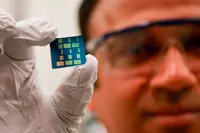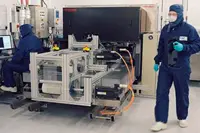Electronics News
Archive : 17 February 2016 год
 The first family in a range of SoCs intended to support 3D instrument clusters has been launched by Renesas. The R-Car D1 Series is intended to provide a smooth migration path for automotive system manufacturers as the use of colour LCD panels in instrument cluster systems becomes more widespread.
The first family in a range of SoCs intended to support 3D instrument clusters has been launched by Renesas. The R-Car D1 Series is intended to provide a smooth migration path for automotive system manufacturers as the use of colour LCD panels in instrument cluster systems becomes more widespread.
In the future, the company believes, display size and resolution are expected to continue increasing, even in low to mid range models. But it notes that, for these systems to become more mainstream, the ability to create displays that make full use of 3D graphics will be required.
The R-Car D1 is said to provide the functionality and performance required and, since Renesas users can take advantage of the R-Car Consortium ecosystem, they will be able to develop 3D graphics cluster systems quickly.
A number of D1 Series SoCs is available. Users can choose from single and dual ARM Cortex-A7 cores, with single core parts running at 660MHz and dual core parts running at 780MHz. 3D graphics on both options are provided by Imagination’s PowerVR SGX540 core. With a range of peripherals, the SoCs are supplied with Ethernet AVB capability and are packaged in a 543ball FCBGA.
Author
Graham Pitcher
Source: www.newelectronics.co.uk
 University of Utah engineers have discovered a 2D semiconducting material that could enable faster devices which consume less power.
University of Utah engineers have discovered a 2D semiconducting material that could enable faster devices which consume less power.
While researchers in this field have recently discovered 2D materials such as graphene, molybdenum disulphide and borophene, these only allow the movement of electrons. According to associate professor Ashutosh Tiwari, pictured, in order to create an electronic device, you need semiconductor material that allows the movement of both electrons and ‘holes’ and the material discovered by Tiwari and his team is claimed to be the first stable P-type 2D semiconductor material.
“Now we have everything,” he said. “We have P-type and N-type 2D semiconductors. Now things will move forward much more quickly.”
Tiwari says devices made with SnO could lead to computers and smartphones that are more than 100 times faster than regular devices whilst generating less heat and consuming less power.
Tiwari believes this could be important for medical devices such as electronic implants that will run longer on a single battery charge.
“The field is very hot right now and people are very interested in it,” Tiwari says. “So, in two or three years, we should see at least some prototype device.”
Pic: Dan Hixson/University of Utah College of Engineering
Author
Graham Pitcher
Source: www.newelectronics.co.uk
 The Centre for Process Innovation (CPI) and Heidelberg Instruments have developed a high resolution, high speed roll to roll digital lithography tool for the manufacture of flexible organic thin film transistors (OTFT) used in next generation applications such as foldable display screens, sensors, integrated circuits and photo-detectors.
The Centre for Process Innovation (CPI) and Heidelberg Instruments have developed a high resolution, high speed roll to roll digital lithography tool for the manufacture of flexible organic thin film transistors (OTFT) used in next generation applications such as foldable display screens, sensors, integrated circuits and photo-detectors.
The machine, installed at CPI’s National Printable Electronics Facility in County Durham, is described as a stepping stone in the commercialisation of printable electronic devices as it provides the ability to continuously manufacture OTFTs directly onto rolls of plastic film at rates approaching 0.1m2/minute.
Products that use thin-film transistors with non-standard shapes and sizes or custom integrated circuits struggle to reach mass market adoption due to the high cost of manufacturing smaller volumes and the limitations imposed by print resolution and production speed. Digital lithography, sometimes referred to as ‘laser direct imaging’ or LDI, eliminates the need for photomasks by guiding a laser with computer generated imagery to directly expose light-sensitive material. This reduces production time and lowers manufacturing cost, opening the technology up for shorter production runs and custom designs.
Roland Kaplan, R&D manger at Heidelberg Instruments, said: “We developed the write engine for this roll to roll lithography tool based on our experiences in high resolution optics, UV Laser and DMD technology. The main aspects were the modularity of the optical engine, the flexibility of the interfaces to the control system and the capability to handle the high speed data volume.”
The key feature of the new tool is its ability to expose rolls of film with digital images generated in real time, allowing it to compensate for any distortions present in each layer of the transistor as it is built up. It does this by using a state-of-the-art optical exposure engine along with a laser and digital mirror device capable of through-putting up to 150Mbytes/s of image data. The system is capable of 4µm line and space resolution in the printed pattern using a print density equivalent to 25,000 dots per inch. It uses an exposure wavelength of 355nm and is compatible with a range of standard i-line photoresist materials as well as being suitable for other UV-curing processes.
Dr Tom Harvey, business development manager at CPI added: “The new tool is available on an open access basis, allowing companies to progress their current sheet processes towards roll to roll production, enabling significant reductions in the costs and times associated with new product development of flexible OTFT arrays.”
The digital lithography line is expected to be of interest to companies who require high resolution continuous patterning of thin films on plastic.
Author
Tom Austin-Morgan
Source: www.newelectronics.co.uk

